

HEAD LICE often are an issue at the beginning of the school year (Entfact 607);
WANDERING SPIDERS are common accidental invaders now (622);
PEST PROOFING (641) is a means of preparing for other accidental invaders- BOXELDER BUGS (444),
CLUSTER FLIES (624), and MULTICOLORED ASIAN LADY BEETLES (416);
FALL ARMYWORMS in pastures (see article below).

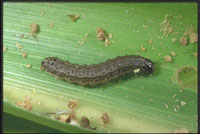
 Information from entomologists at the University of Tennessee Experiment Station at Jackson indicates several counties in west Tennessee are experiencing outbreak levels of fall armyworm in pastures. Our pheromone trap counts in KY have increased, but not very much. Pheromone trap counts in Jackson and Milan, TN show larger increases in moth capture but we have little data with which to compare these values. It is hard to judge whether or not this will be a problem for us this fall, but this insect is always a potential problem. Certainly the activity in west Tennessee is an indicator of increased risk in west Kentucky.
Information from entomologists at the University of Tennessee Experiment Station at Jackson indicates several counties in west Tennessee are experiencing outbreak levels of fall armyworm in pastures. Our pheromone trap counts in KY have increased, but not very much. Pheromone trap counts in Jackson and Milan, TN show larger increases in moth capture but we have little data with which to compare these values. It is hard to judge whether or not this will be a problem for us this fall, but this insect is always a potential problem. Certainly the activity in west Tennessee is an indicator of increased risk in west Kentucky.
Potential problem areas include pastures, early planted small grains, fall seeded alfalfa, fall seeded grasses of any kind e.g. yards, playing fields, roadsides, mine reclamation etc.
Potential threat will continue until a hard frost. In no-tillage or in situations with ground cover, this insect will survive several light frosts. It does NOT over winter in KY.
Watch this newsletter for additional information.


![]() Soybean aphids continue to be few and far between. Small numbers of aphids continue to be reported from Fayette, Shelby and Oldham county sentinel fields. But there are no current reports of aphids from sentinel plots or production fields in the area of major soybean concentration. Capture2 of aphids in Kentucky's two soybean suction traps are extremely low.
Soybean aphids continue to be few and far between. Small numbers of aphids continue to be reported from Fayette, Shelby and Oldham county sentinel fields. But there are no current reports of aphids from sentinel plots or production fields in the area of major soybean concentration. Capture2 of aphids in Kentucky's two soybean suction traps are extremely low.
Warning: It is unlikely that economically significant soybean aphid populations will occur in Kentucky this year, but it is not impossible. Producers and consultants working with very late planted or late maturing beans should continue to be watchful. The largest populations of soybean aphid in Kentucky are usually reported during the third week of September on late-maturing beans.
For more information about soybean pests, visit
"Insect Management Recommendations".


 The latest report (as of 20 September) on West Nile virus in Kentucky is available from the Kentucky Cabinet for Health and Family Services web site at
http://chfs.ky.gov/NR/rdonlyres/FB01CA5C-219F-4434-AE66-7D8AAF7BFFD2/0/Wnvmap92007.pdf
The latest report (as of 20 September) on West Nile virus in Kentucky is available from the Kentucky Cabinet for Health and Family Services web site at
http://chfs.ky.gov/NR/rdonlyres/FB01CA5C-219F-4434-AE66-7D8AAF7BFFD2/0/Wnvmap92007.pdf
Here is a comparison of cases so far in 2007 compared to the two previous years. Keep in mind that mosquitoes can remain active for several more weeks this fall.
| Cases | 2005 | 2006 | 2007 to date |
|---|---|---|---|
| Human | 5 | 5 | 3 |
| Horse | 9 | 14 | 1 |
| Bird | 6 | 2 | 3 |
The latest review of home mosquito control can be found in KPN issue 1099.
http://www.uky.edu/Ag/kpn/kpn_06/pn060703.htm#house It's good information to review if you are still getting bitten.

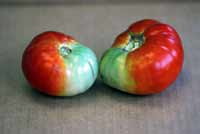 Well it's been another unusual year as usual! It's been hot and dry since May and summer is now slowly releasing its grip and reluctantly giving way to more typical fall weather patterns. So what does this have to do with insect problems? Well, nearly everything. One of the more notable and unusual problems has been the large numbers of whiteflies, particularly the silverleaf whitefly, Bemisia argentifolii. We have seen very high numbers this year as hot, dry weather (which there has been no lack of this summer) favors the buildup of this insect.
Well it's been another unusual year as usual! It's been hot and dry since May and summer is now slowly releasing its grip and reluctantly giving way to more typical fall weather patterns. So what does this have to do with insect problems? Well, nearly everything. One of the more notable and unusual problems has been the large numbers of whiteflies, particularly the silverleaf whitefly, Bemisia argentifolii. We have seen very high numbers this year as hot, dry weather (which there has been no lack of this summer) favors the buildup of this insect.
We have seen some unusual problems associated with this whitefly this year, including silverleafing of squash (hence the name silverleaf whitefly) and irregular ripening of tomatoes. Two weeks ago Dr. Tim Coolong and I reported on the silverleaf of cucurbits, but the irregular ripening of tomatoes is a new report. There are a number of causes of irregular ripening of tomatoes that includes yellow shouldering, gray wall and blotchy ripening. The causes of these are often attributed to nutrients (potassium/nitrogen) balances and environmental conditions (soil compaction, cool-wet weather, or very hot weather). However, the irregular ripening caused by silverleaf whitefly appears a bit different than the other types of ripening disorders. What we observed is that if one looked at the fruit from above, a section of the fruit did not ripen and remained green to the core, while the rest ripened normally. In some instances, one half of the fruit would be ripe while the other side was green. Only moderate infestation of silverleaf whitefly was noted on these plants. Research in Florida noted that densities of 5 to 10 nymphs per leaflet may be used as a threshold for management of silverleaf whitefly and irregular ripening on tomato.
Besides the noted problems on cucurbits and tomatoes, high silverleaf whitefly numbers have been observed on a large number of other plants. On most of these the damage is not important. Whitestalk in broccoli, another disorder that can appear with this pest, has not been reported in Kentucky. As homeowners prepare to bring in houseplants prior to the first killing frosts this fall, care should be taken to avoid bringing whitefly infested plants indoors.


Oak wilt, a fungal disease caused by Ceratocystis fagacearum, was detected in a bur oak (Quercus macrocarpa) sample sent to the plant disease diagnostic laboratory last week. The disease may be affecting several bur oaks growing in the Louisville area.
Symptoms. Wilted leaves may appear dull green or tan in color, sometimes with marginal necrosis, or leaves may droop and curl. Symptoms typically appear in the top portion of the tree or on scattered branches throughout the tree. It would be easy to confuse this disease with bacterial leaf scorch, especially this time of year. Also, drought has caused much leaf fading and death of oaks this year, which could be confused with oak wilt. Oak wilt also causes internal dark streaks in the xylem within the infected trunks or branches; discolored xylem is not a symptom of bacterial leaf scorch or drought. In any case, special laboratory testing is needed for an accurate diagnosis. In the case of the Jefferson County sample, cultures were made from discolored xylem pieces and identified as C. fagacearum.
The oak wilt fungus grows systemically and often kills infected trees. The disease-causing fungus moves from tree to tree via sap-feeding beetles which carry spores from fungal mats on dead trees to wounds on healthy trees nearby. The fungus can also move through root grafts from diseased to adjacent healthy trees nearby.
There are still some puzzling aspects to this case of oak wilt. Although bur oak is susceptible to oak
wilt disease, it is not considered to be as susceptible as red oaks and other members of the red oak
group. Also, we have not observed very many cases of oak wilt in Kentucky over a period of many
years. Perhaps drought is making the disease worse and more noticeable. It remains to be seen if
oak wilt is to become an important problem in Kentucky.


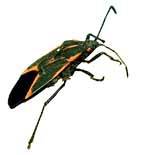 Boxelder bugs are common insects that feed on sap from leaves, twigs, and seeds of boxelders, as well other members of the maple family. Large numbers of them accumulate in the fall and can be seen on tree trunks, or branches, or sunning themselves on the south or west sides of buildings. This harmless accidental invader may be a temporary nuisance as it moves into sheltered sites to spend the winter.
Boxelder bugs are common insects that feed on sap from leaves, twigs, and seeds of boxelders, as well other members of the maple family. Large numbers of them accumulate in the fall and can be seen on tree trunks, or branches, or sunning themselves on the south or west sides of buildings. This harmless accidental invader may be a temporary nuisance as it moves into sheltered sites to spend the winter.
Adult boxelder bugs are elongate, 1/2 inch long insects with sucking mouthparts. They are mostly black with some red markings. There are three narrow red lines on the segment behind the head, one down the center and one on each side and a thin red inverted "V" about the middle of the back. The wingless immature or nymphal stage has a black head, antennae, and legs. The red abdomen has an orange-yellow stripe and spot down the center of the back.
Boxelder bugs feed on plants during the summer. They move to sheltered areas (including nearby houses and buildings) in the fall and remain there during the winter. Sweep or vacuum up and discard those found inside. They will not multiply nor will they infest any household articles. These insects are only a nuisance or accidental invader; however, they may leave an odor and stain when crushed.
Exclusion is important in reducing numbers that get indoors. Check door sweeps and places outside the house that may allow them to get inside. If large numbers are present every year, removal of female boxelder plants should be considered because this is the major host plant for them. Other alternatives include controlling insects while they are on the boxelder plant or direct sprays of congregations of the insects on outside walls. Insecticidal soap provides a safe control alternative but it must be sprayed directly on the insects to be effective
 Wasp stings are a serious health threat to humans and animals. Many people in the United States die each year from allergic reactions to the venom of these insects. Paper wasps, hornets and yellowjackets are more dangerous and unpredictable than honeybees. Workers foraging away from the nest are seldom aggressive, but nests should be eliminated with great care and in a specific manner. "Folk" remedies such as dousing nests with gasoline or a garden hose seldom work and can result in multiple stings.
Wasp stings are a serious health threat to humans and animals. Many people in the United States die each year from allergic reactions to the venom of these insects. Paper wasps, hornets and yellowjackets are more dangerous and unpredictable than honeybees. Workers foraging away from the nest are seldom aggressive, but nests should be eliminated with great care and in a specific manner. "Folk" remedies such as dousing nests with gasoline or a garden hose seldom work and can result in multiple stings.
Paper Wasps -- Paper wasps (as well as hornets and yellowjackets) construct nests of a paper-like material containing finely chewed wood fragments and salivary secretions. Paper wasps typically build their umbrella-shaped nests in protected locations, such as under eaves, gutters and ledges or in attics and outbuildings. Nests also may be located behind shutters, or inside exterior light fixtures, gas grills and mailboxes. Most paper wasps are brownish or rust-colored, although one increasingly common variety, the European paper wasp, has yellow and black markings much like a yellowjacket. Paper wasps have a "waist" that is very thin, however, which distinguishes them from hornets and yellowjackets.
Paper wasps are not very aggressive, but stings can occur when householders inadvertently disturb nests that are hidden. If the nest is accessible, it can be eliminated rather easily with a wasp and hornet spray sold at most retail stores. One advantage of these formulations is that they can be sprayed as far as 20 feet. Although it's best to treat all wasp nests at night, paper wasps can be eliminated during the daytime provided you do not stand directly below the nest during treatment. Most wasp aerosol sprays cause insects to drop instantly. Standing directly under a nest increases the risk of being stung. After treatment, wait a day to ensure that the colony is destroyed; then scrape or knock down the nest.
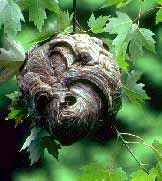 Hornets -- Hornets are far more difficult and dangerous to control than paper wasps. The nests resemble a large, gray, bloated football, which typically is attached to a tree, bush or side of a building. Oftentimes the nest is concealed among branches, especially in densely canopied trees such as Bradford pear. Hornet nests may contain thousands of wasps that are extremely aggressive when disturbed. The nests often are located out of reach and elimination is best accomplished by a professional pest control firm.
Hornets -- Hornets are far more difficult and dangerous to control than paper wasps. The nests resemble a large, gray, bloated football, which typically is attached to a tree, bush or side of a building. Oftentimes the nest is concealed among branches, especially in densely canopied trees such as Bradford pear. Hornet nests may contain thousands of wasps that are extremely aggressive when disturbed. The nests often are located out of reach and elimination is best accomplished by a professional pest control firm.
Treat hornet nests at night when most insects are within the nest and less active (follow night treatment precautions discussed below for yellowjackets). A full wasp suit, sealed at the wrists, ankles and collar, is recommended. Apply an aerosol-type wasp and hornet spray or dust formulation (e.g., Sevin, Drione, DeltaDust) directly into the nest opening. Hornet nests generally have a single opening, usually toward the bottom, where the wasps enter and exit. It is crucial that the paper envelope of the nest not be broken during treatment or the irritated wasps will scatter in all directions, causing even greater problems. Following treatment, wait at least 2-3 days before removing the nest to ensure that all of the wasps are killed. If hornets continue to be seen, the application may need to be repeated.
If the nest is located away from frequently used areas, another option is to wait and do nothing. In Kentucky, wasp, hornet, yellowjacket, and bumblebee colonies die off naturally after the weather turns cold, and the paper carton disintegrates over the winter months.
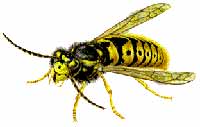 Yellowjackets -- Yellowjackets are probably the most dangerous stinging insects in the United States. They tend to be unpredictable and usually sting if the nest is disturbed. Yellowjacket nests are often located underground in old animal burrows (e.g., chipmunks), or beneath rocks or landscape timbers. They also build nests in walls, attics, crawlspaces, and behind exterior siding of buildings.
Yellowjackets -- Yellowjackets are probably the most dangerous stinging insects in the United States. They tend to be unpredictable and usually sting if the nest is disturbed. Yellowjacket nests are often located underground in old animal burrows (e.g., chipmunks), or beneath rocks or landscape timbers. They also build nests in walls, attics, crawlspaces, and behind exterior siding of buildings.
If the nest can be located, it often can be eliminated by applying an aerosol-type wasp and hornet spray into the opening. Insecticide dust formulations containing Sevin (sold in lawn and garden shops), DeltaDust, or Drione, are especially effective but require a hand duster to dispense several puffs of the dust into the nest opening. In lieu of a commercial duster, a workable alternative is to use a dry, empty liquid detergent bottle filled with an inch or so of dust. A few pebbles or marbles added to the bottom prevents the dust from caking, and the bottle should be shaken before dispensing. (Remember to dispose of the bottle after use, or store it away from children and pets). Dusts tend to be more effective than aerosols when the nest itself is located some distance from the entrance hole - as often occurs when yellowjackets construct nests behind exterior siding or deep within abandoned animal burrows. Insecticide dust blown into the opening penetrates farther than sprays, and the workers transport it throughout the nest.
Ideally, treatment should be performed at night, when most of the yellowjackets are in the nest and less active. Pinpoint the nest opening during the daytime, so you will remember where to direct your treatment after dark. Approach the nest slowly and do not shine the beam of your flashlight directly into the nest entrance as this may startle the wasps and cause them to fly toward the light. Instead, cast the beam to the side to illuminate the nest indirectly. If possible, place the light on the ground rather than in your hand.
When contemplating extermination of a yellowjacket or hornet nest, clients should be informed that they are entering a DANGER ZONE - there is no pest control scenario more frightening than a 'blown' wasp or hornet treatment. It is often prudent to refer homeowners to a professional, especially when access to the nest requires a ladder or is difficult.
Wasp, hornet and yellowjacket stings can be life threatening to persons who are allergic to the venom. People who develop hives, dizziness, breathing or swallowing difficulty, wheezing, or similar symptoms of allergic reaction should seek medical attention immediately. Itching, pain, and localized swelling can be reduced with antihistamines and an ice pack.


Over the past two weeks, agronomic samples have begun to taper off, but we have received quite a few ornamental and vegetable samples. Charcoal rot was diagnosed on field corn, and a few cases of black shank and brown spot were seen on tobacco.
Vegetable samples included Fusarium fruit decay on cucumber and pumpkin, as well as belly rot (Rhizoctonia) on pumpkin; anthracnose ("ripe rot") and Rhizoctonia root/stem rot on pepper; and yellow shoulders, poor fruit set (due to high temperatures), stinkbug injury and Pythium root rot on tomato.
On herbaceous ornamentals we have seen Fusarium wilt, Rhizoctonia root rot, iron deficiency and fertilizer burn on chrysanthemum; Pythium root rot on feverfew and dipladenia/mandevilla; bacterial soft rot on petunia; anthracnose on epimedium and begonia; borer injury on iris; root knot nematode on sedum; web blight (Rhizoctonia) on Boston fern; and Volutella blight on pachysandra.
On woody ornamentals, we have diagnosed Botryosphaeria canker on rhododendron; black root rot on holly; powdery mildew on dogwood; Phytophthora root rot on taxus and cherrylaurel; Hypoxylon canker and tar spot on maple; Dothistroma needle blight pine; oak wilt (Ceratocystis) on oak; bacterial leaf scorch on oak and ash; and drought stress symptoms on many landscape plants, particularly conifers such as spruce and hemlock.


August 31-September 5, 2007
UKREC-Princeton, KY
| Black Cutworm
| 6
| True Armyworm
| 2
| Corn Earworm
| 57
| European Corn Borer
| 2
| Southwestern Corn Borer
| 4
| Fall armyworm
| 66
| | |
Lexington, KY
| Black Cutworm
| 6
| True Armyworm
| 0
| Corn Earworm
| 25
| European Corn Borer
| 7
| Southwestern Corn Borer
| 1
| Fall armyworm
| 3
| | |
This season insect trap counts will be provided for locations in Kentucky and Tennessee.
View trap counts for past seasons and the entire 2007 season at -
http://www.uky.edu/Ag/IPMPrinceton/Counts/2006trapsfp.htm
View trap counts for Fulton County, Kentucky at -
http://ces.ca.uky.edu/fulton/anr/
For information on trap counts in southern Illinois visit the Hines Report at -
http://www.ipm.uiuc.edu/pubs/hines_report/comments.html
The Hines Report is posted weekly by Ron Hines, Senior Research Specialist, at the
University of Illinois Dixon Springs Agricultural Center.
NOTE: Trade names are used to simplify the information presented in this newsletter. No endorsement by the Cooperative Extension Service is intended, nor is criticism implied of similar products that are not named.
Lee Townsend
Extension Entomologist